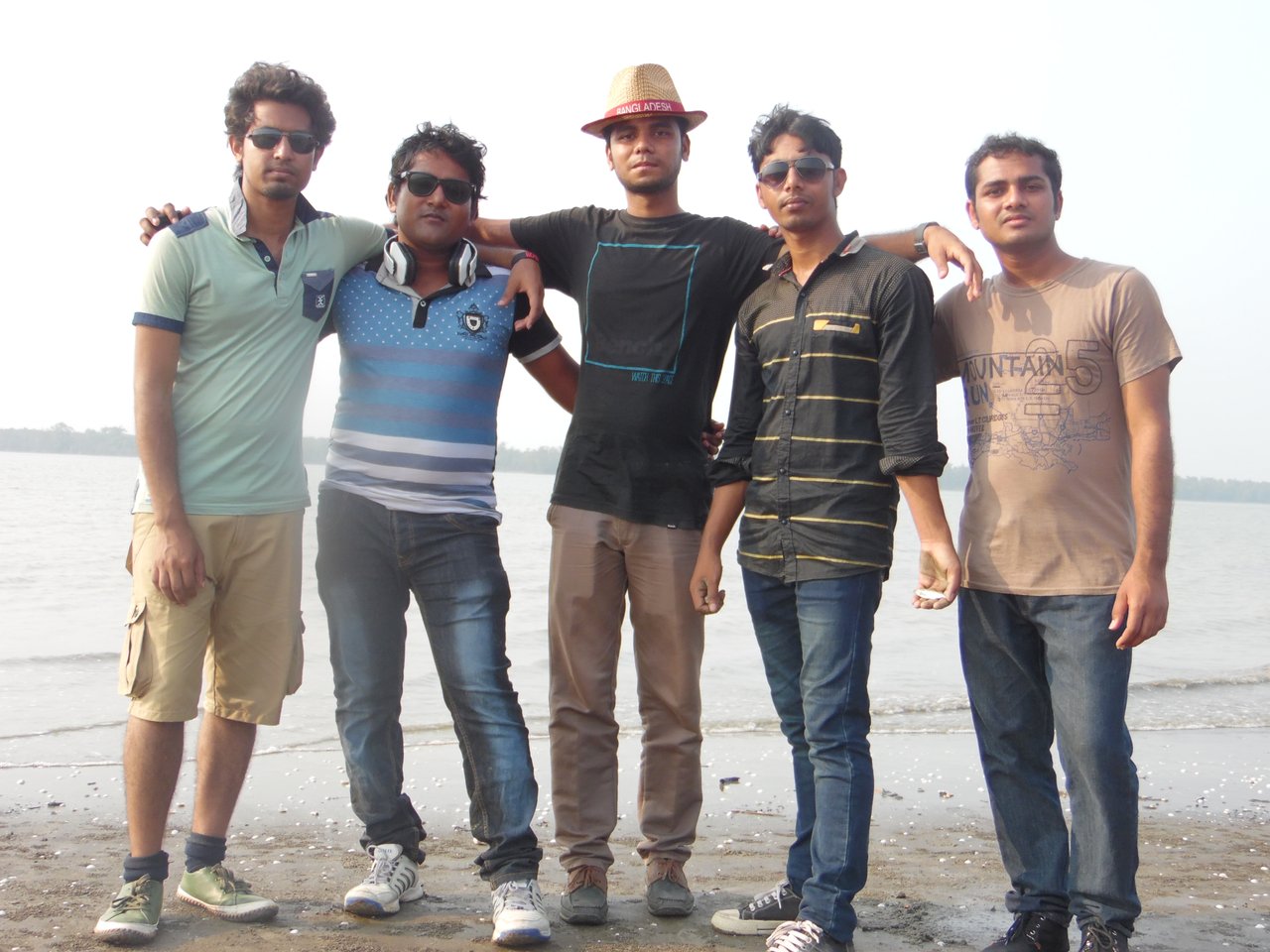 KUAKATA: A memorable tour with lifetime feelings of the amazing beauty!
KUAKATA: A memorable tour with lifetime feelings of the amazing beauty!
IT was 2016 when I last visited Kuakata with some of my friends as a group of 6 people. It was one of the most memorable travels in my life. At that time i was studying in a university in Bangladesh which was at the southern part of the country. So, it was much more convenient to go to the furthest southern point of Bangladesh and only in this area of Bangladesh is the door of the open door!
At that time, the journey was not so easy as nowadays as the whole way is now without any ferry transportation which was hectic with time killing process. But now all the rivers have connecting bridges and it saves time to travel to the southern part more easily. Currently we are living a new world after the Covid pandemic and here in China, I am living in a kind of lockdown. So, I am missing these sweet memories. Hope to go there soon to explore the beauty of the sea!
Looking at the articles and photos of my wonderful Bangladeshi friend @tanzil2024 I enjoy the act of spreading the wings of my imagination!
Actually, I don't know much about Bangladesh, but I am very interested in Indian civilization!
Since Buddhism, a branch of Hinduism in India, was first introduced to China 2000 years ago, Indian civilization has received a lot of attention from East Asians!
The reason is that Hindu culture in India has had a great influence on the birth and development of Chinese, Japanese, Korean, and Vietnamese civilizations since ancient times.
Meeting of Indian and East Asian civilizations!
Hindu culture, religion, science, and philosophy in India have had a great influence on the birth and development of East Asian civilizations.
Did my friend Hassan's Chinese friends tell him about it?😄
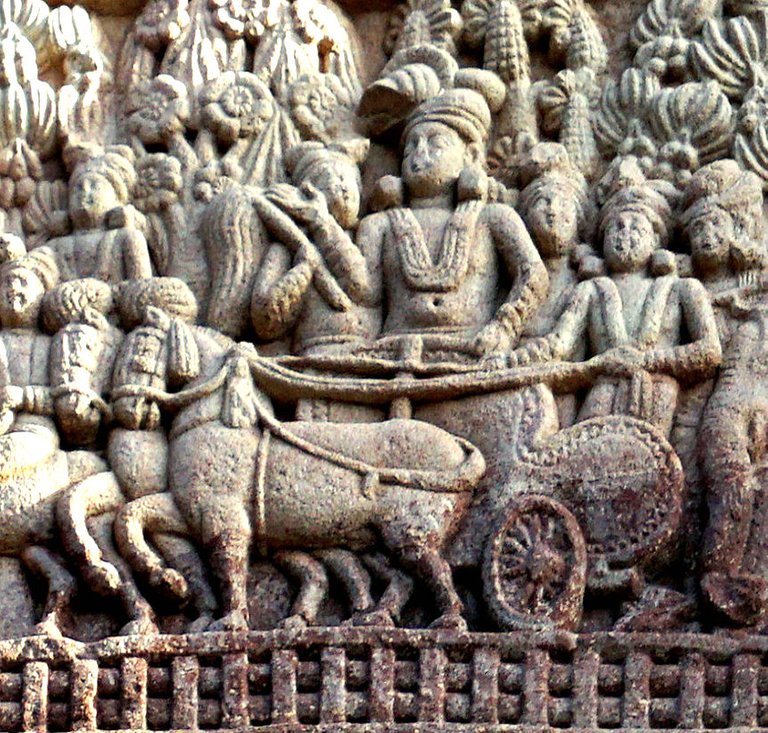 A c. 1st century BCE/CE relief from Sanchi, showing Ashoka on his chariot, visiting the Nagas at Ramagrama.[1][2]
A c. 1st century BCE/CE relief from Sanchi, showing Ashoka on his chariot, visiting the Nagas at Ramagrama.[1][2]
Ashoka (/əˈʃoʊkə/) Asoka,[5] IAST: Aśoka; c. 304 – 232 BCE), popularly known as Ashoka the Great, was an Indian emperor of the Maurya Empire, son of Bindusara, who ruled almost the entire Indian subcontinent from c. 268 to 232 BCE.[6][7] Ashoka promoted the spread of Buddhism across ancient Asia.[4] Considered by many to be one of India's greatest emperors, Ashoka expanded Chandragupta's empire to reign over territory stretching from present-day Afghanistan in the west to present-day Bangladesh in the east. It covered the entire Indian subcontinent except for parts of present-day Kerala and Tamil Nadu.[8] The empire's capital was Pataliputra (in Magadha, present-day Patna), with provincial capitals at Takshashila (later Taxila) and Ujjain. Ashoka, after the war of Kalinga, was upset with the bloodshed and vowed to never again wage a war of conquest. He patronised Buddhism during his reign.
Ashoka waged a particularly destructive war against the state of Kalinga,[9] which he conquered in about 260 BCE.[10] According to an interpretation of his Edicts, he converted to Buddhism[9] after witnessing the mass deaths of the Kalinga War, which he had waged out of a desire for conquest and which reportedly directly resulted in more than 100,000 deaths and 150,000 deportations.[11] He is remembered for erecting the Ashoka pillars and spreading his Edicts,[12] for sending Buddhist monks to Sri Lanka and Central Asia,[4] and for establishing monuments marking several significant sites in the life of Gautama Buddha.[13]
Beyond the Edicts of Ashoka, biographical information about him relies on legends written centuries later, such as the 2nd-century CE Ashokavadana ("Narrative of Ashoka", a part of the Divyavadana), and in the Sri Lankan text Mahavamsa ("Great Chronicle"). The emblem of the modern Republic of India is an adaptation of the Lion Capital of Ashoka. His Sanskrit name "Aśoka" means "painless, without sorrow" (the a privativum and śoka, "pain, distress"). In his edicts, he is referred to as Devānāmpriya (Pali Devānaṃpiya or "the Beloved of the Gods"), and Priyadarśin or Priyadarshi (Pali Piyadasī or "He who regards everyone with affection"). His fondness for a tree is the reason for his name being connected to the "Ashoka tree" or Saraca asoca, and this is referenced in the Ashokavadana.
In The Outline of History (1920), H. G. Wells wrote, "Amidst the tens of thousands of names of monarchs that crowd the columns of history, their majesties and graciousnesses and serenities and royal highnesses and the like, the name of Ashoka shines, and shines, almost alone, a star."[14]
Ashoka (/əˈʃoʊkə/) Asoka,[5] IAST: Aśoka; c. 304 – 232 BCE) was the greatest hero who first unified the Indian subcontinent.
After countless massacres, he suddenly became an ardent Buddhist. After establishing India as a Buddhist empire, he began to spread Buddhism throughout Asia.
At that time, India was a much more developed and prosperous civilization empire than China, so the Chinese began to take an interest in Indian Buddhism and culture.


Just as many modern East Asian men like me are attracted to the sensuality of Indian women, ancient East Asian men were attracted to the sensual Indian culture!😘
So, many East Asian men, including China, visited India.
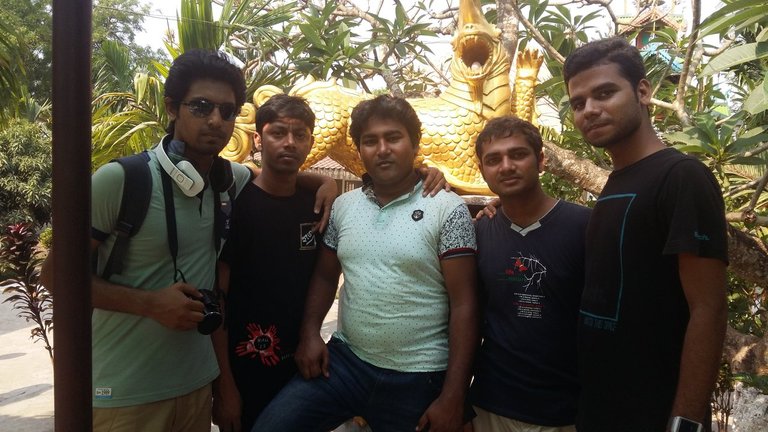
My handsome friend Hassan went to China, but 2000 years ago, Chinese men went to India.
Hassan is the shortest among the men in the photo, but the most handsome!😃
Hassan's brightest eyes have more impact than other men!
I will now tell Hasan about the many East Asian men who have visited India since 2000 years ago.
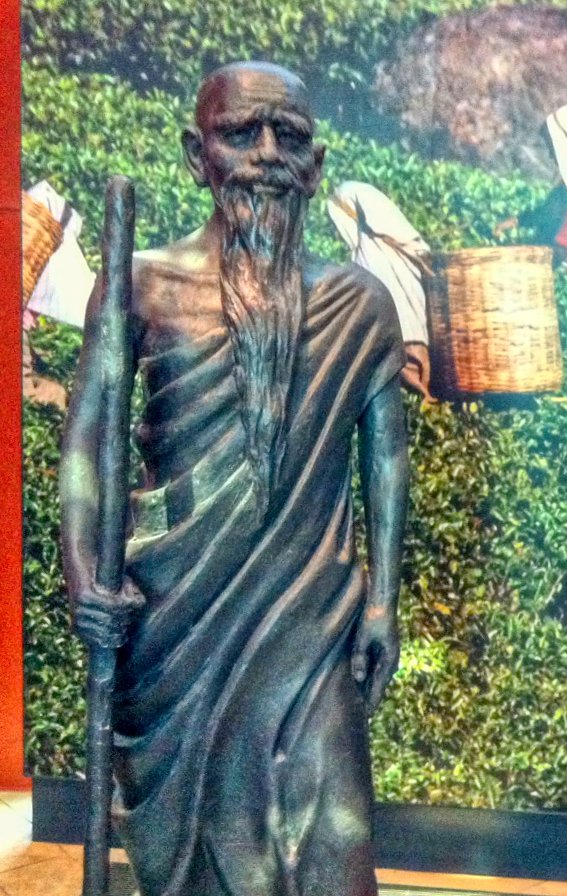 An honorary Faxian statue in a Singapore museum.
An honorary Faxian statue in a Singapore museum.
Faxian ([fà.ɕjɛ̀n]; 337 CE – c. 422 CE), also referred to as Fa-Hien, Fa-hsien and Sehi, was a Chinese Buddhist monk and translator who traveled by foot from China to India to acquire Buddhist texts. Starting his arduous journey about age 60, he visited sacred Buddhist sites in Central, South and Southeast Asia between 399 and 412 CE, of which 10 years were spent in India.[1][2][3]
He described his journey in his travelogue, A Record of Buddhist Kingdoms(佛國記) . His memoirs are notable independent record of early Buddhism in India. He took with him a large number of Sanskrit texts, whose translations influenced East Asian Buddhism and which provide a terminus ante quem for many historical names, events, texts, and ideas therein.[1][2]
Faxian 法顯 ([fà.ɕjɛ̀n]; 337 CE – c. 422 CE) was probably the first Chinese to visit India in Chinese historical records.
The cities and towns of this country [Magadha] are the greatest of all in the Middle Kingdom [Mathura through Deccan]. The inhabitants are rich and prosperous, and vie with one another in the practice of benevolence and righteousness. Every year on the eighth day of the second month they celebrate a procession of images. They make a four-wheeled car, and on it erect a structure of four storeys by means of bamboos tied together. This is supported by a king-post, with poles and lances slanting from it, and is rather more than twenty cubits high, having the shape of a tope. White and silk-like cloth of hair is wrapped all round it, which is then painted in various colours. They make figures of devas, with gold, silver, and lapis lazuli grandly blended and having silken streamers and canopies hung out over them. On the four sides are niches, with a Buddha seated in each, and a Bodhisattva standing in attendance on him. There may be twenty cars, all grand and imposing, but each one different from the others. On the day mentioned, the monks and laity within the borders all come together; they have singers and skillful musicians; they pay their devotion with flowers and incense. The Brahmans come and invite the Buddhas to enter the city. These do so in order, and remain two nights in it. All through the night they keep lamps burning, have skillful music, and present offerings. This is the practice in all the other kingdoms as well. The Heads of the Vaisya families in them establish in the cities houses for dispensing charity and medicines. All the poor and destitute in the country, orphans, widowers, and childless men, maimed people and cripples, and all who are diseased, go to those houses, and are provided with every kind of help, and doctors examine their diseases. They get the food and medicines which their cases require, and are made to feel at ease; and when they are better, they go away of themselves.
— Faxian, c. 415 CE[8]
While traveling in India, Faxian 法顯 ([fà.ɕjɛ̀n]; 337 CE – c. 422 CE) ([fà.ɕjɛ̀n]; 337 CE – c. 422 CE) was impressed with the charitable and medical practices of Indian Buddhism to the poor and the sick.
The development and prosperity of India was revealed in the A Record of Buddhist Kingdoms (Foguo Ji Foguo 佛國記), a record of Faxian 法顯 ([fà.ɕjɛ̀n]; 337 CE – c. 422 CE).
At that time, China was in an era of war through The Sixteen Kingdoms (simplified Chinese: 十六国; traditional Chinese: 十六國; pinyin: Shíliù Guó), so Chinese kings envy India's prosperity and development.
So, the kings of China wanted to end the war by spreading Buddhism in India to the Chinese.
It was believed that Buddhism's belief in peace, mercy, and prohibition of killing would purify the Chinese people's desire for war.
The kings of China believed that Buddhism in India would weaken the Chinese people's desire to kill, plunder, and conquer, making them civilized.
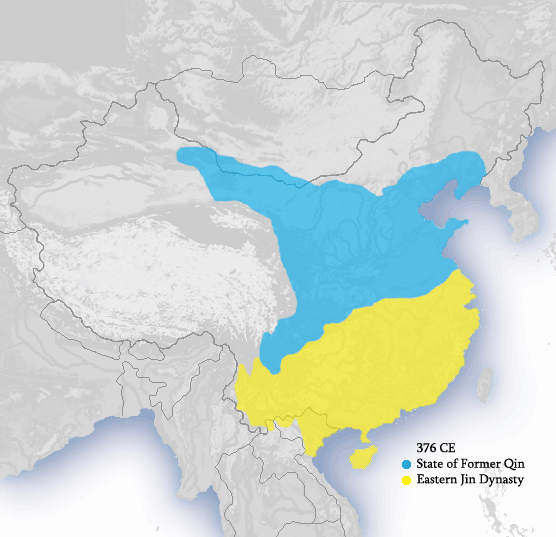 Territory of the Former Qin kingdom and the Jin dynasty in 376.
Territory of the Former Qin kingdom and the Jin dynasty in 376.
The Sixteen Kingdoms (simplified Chinese: 十六国; traditional Chinese: 十六國; pinyin: Shíliù Guó), less commonly the Sixteen States, was a chaotic period in Chinese history from AD 304 to 439 when northern China fragmented into a series of short-lived dynastic states. The majority of these states were founded by the "Five Barbarians", non-Han peoples who had settled in northern and western China during the preceding centuries, and had launched a series of rebellions and invasions against the Western Jin dynasty in the early 4th century. However, several of the states were founded by the Han people, and all of the states—whether ruled by Xiongnu, Xianbei, Di, Jie, Qiang, Han, or others—took on Han-style dynastic names. The states frequently fought against both one another and the Eastern Jin dynasty, which succeeded the Western Jin in 317 and ruled southern China. The period ended with the unification of northern China in 439 by the Northern Wei, a dynasty established by the Xianbei Tuoba clan. This occurred 19 years after the Eastern Jin collapsed in 420, and was replaced by the Liu Song dynasty. Following the unification of the north by Northern Wei, the Northern and Southern dynasties era of Chinese history began.
The term "Sixteen Kingdoms" was first used by the 6th-century historian Cui Hong in the Spring and Autumn Annals of the Sixteen Kingdoms and refers to the five Liangs (Former, Later, Northern, Southern and Western), four Yans (Former, Later, Northern, and Southern), three Qins (Former, Later and Western), two Zhaos (Former and Later), Cheng Han and Xia. Cui Hong did not count several other kingdoms that appeared at the time including the Ran Wei, Zhai Wei, Chouchi, Duan Qi, Qiao Shu, Huan Chu, Tuyuhun and Western Yan. Nor did he include the Northern Wei and its predecessor Dai, because the Northern Wei is considered to be the first of the Northern Dynasties in the period that followed the Sixteen Kingdoms.
Classical Chinese historians called the period the "Sixteen Kingdoms of the Five Barbarians" (simplified Chinese: 五胡十六国; traditional Chinese: 五胡十六國; pinyin: Wǔhú Shíliù Guó) because of the active roles played by non-Han ethnicities during this period. Even among the states founded by ethnic Han (Former Liang, Western Liang, Ran Wei and Northern Yan), several founders had close relations with ethnic minorities. For example, the father of Ran Min, who founded Ran Wei, was adopted by a Later Zhao ruling family. Feng Ba, who is considered by some historians to be the founder of the Northern Yan, was an ethnic Han who had prominent Xianbei friends, as well as a Xianbei nickname. Gao Yun, considered by other historians to be the Northern Yan founder, was a member of the Goguryeo royal family who had been adopted by Xianbei nobility.
Due to fierce competition among the states and internal political instability, the kingdoms of this era were mostly short-lived. For seven years from 376 to 383, the Former Qin briefly unified northern China, but this ended when the Eastern Jin inflicted a crippling defeat on it at the Battle of Fei River, after which the Former Qin splintered and northern China experienced even greater political fragmentation. The fall of the Western Jin dynasty amidst the rise of non-Han regimes in northern China during the Sixteen Kingdoms period resembles the fall of the Western Roman Empire amidst invasions by the Huns and Germanic tribes in Europe, which also occurred in the 4th to 5th centuries.
 Monasticism: Buddhist monks at Jintai Temple in Zhuhai, Guangdong, mainland China.
Monasticism: Buddhist monks at Jintai Temple in Zhuhai, Guangdong, mainland China.
Chinese Buddhism or Han Buddhism (simplified Chinese: 汉传佛教; traditional Chinese: 漢傳佛教; pinyin: Hànchuán Fójiào) is a Chinese form of Mahayana Buddhism which has shaped Chinese culture in a wide variety of areas including art, politics, literature, philosophy, medicine and material culture. Chinese Buddhism is the largest institutionalized religion in Mainland China.[1] Currently, there are an estimated 185 to 250 million Chinese Buddhists in the People's Republic of China[1] It is also a major religion in Taiwan and among the Chinese Diaspora.
Buddhism was first introduced to China during the Han Dynasty (202 BCE–220 CE). The translation of a large body of Indian Buddhist scriptures into Chinese and the inclusion of these translations (along with Taoist and Confucian works) into a Chinese Buddhist canon had far-reaching implications for the dissemination of Buddhism throughout the East Asian cultural sphere, including Korea, Japan and Vietnam. Chinese Buddhism also developed various unique traditions of Buddhist thought and practice, including Tiantai, Huayan, Chan Buddhism and Pure Land Buddhism.
From its inception, Chinese Buddhism has been influenced by native Chinese religions and philosophy, especially Confucianism and Taoism, but also Chinese folk religion.
As a result, Buddhism in India prospered in China and again contributed to the unification and development of Chinese civilization.
As Buddhist culture flourished in China, Vietnam, Korea, and Japan also imported Buddhism, and the East Asian world accepted Buddhism as a universal culture.
Thanks for letting me know the history
I am happy to about the interest of eastern people in Indian beauty but most of south Asian people think eastern people are very beautiful as they are bright in color than the average south Asian people!
!PIZZA
Dear @tanzil2024!
I was surprised that South Asians envy the skin color of East Asians.😲
Ordinary S.K men find the slightly darker skin tone of Indian women sexy and beautiful.😄
It's true indeed due to the colonial era for almost 200 years, people have the mindset of white supremacy related thoughts, it's cultural but nowadays the situation is changing but the effect is still observable in south Asian countries!
I think it's dishonorable for Asians to discriminate against each other because of the color of their skin!😯
I think the white supremacy of Europeans was the cause of such behavior!😟
Congratulations @goldgrifin007! You have completed the following achievement on the Hive blockchain and have been rewarded with new badge(s):
Your next target is to reach 3500 comments.
You can view your badges on your board and compare yourself to others in the Ranking
If you no longer want to receive notifications, reply to this comment with the word
STOPTo support your work, I also upvoted your post!
Check out the last post from @hivebuzz:
PIZZA Holders sent $PIZZA tips in this post's comments:
@tanzil2024(1/5) tipped @goldgrifin007 (x1)
You can now send $PIZZA tips in Discord via tip.cc!